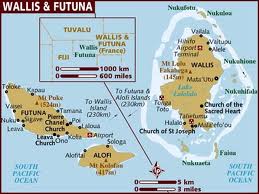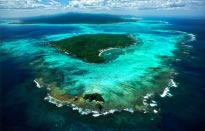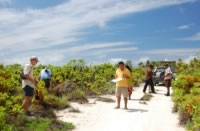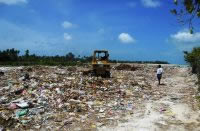PEIN Country Profile and Virtual Environment Library
 Wallis and Futuna
Wallis and Futuna

Mata-Utu
Region:
Polynesia - Pacific (Oceania)
Languages:
Wallisian, Futunan, French
National Focal Points for Environment:
Programmation 10 FED / Cooperation regionale Dossiers economiques et financiers
Overview
see BIODIVERSITÉ ET CONSERVATION EN OUTRE-MER - Pacifique: Wallis and Futuna
Etat des milieux à Wallis et Futuna
Etat des connaissances
Les récifs coralliens de Wallis et Futuna sont pratiquement inconnus. A ce jour, il n’ont fait l’objet que d’une seule étude qui date de 1980 (Richard et alii, 1982 ; Galzin et Mauge, 1981).
Typologie et distribution des écosystèmes
Futuna et Alofi se distinguent de Wallis, par l’absence totale (cas de Futuna) ou partielle (cas d’Alofi) de lagon.
A Wallis, l’Ile d’Uvea est entourée d’une barrière corallienne régulière et continue, qui délimite un lagon d’environ 65 km2. La couronne récifale est fortement dissymétrique : le côté est, plus battu, comporte 19 Ilots, d’origine corallienne et/ou basaltique ; la bordure ouest, plus abritée, comprend trois des quatre passes. La quatrième passe située au sud de l’Ile est la seule praticable par les gros navires. La zone orientale du lagon est la plus profonde (40 m dans la baie de Mata-Utu) et présente peu de formations coralliennes vivantes. La zone occidentale, moins profonde, présente un récif frangeant plus étendu et fréquemment envahi par la mangrove aux abords de l’Ile. Les zones coralliennes vivantes y sont plus importantes qu’à l’est. Mais, les formations madréporiques sont mal représentées à l’intérieur même du récif et la grande richesse du lagon de Wallis est surtout due à la présence d’herbiers très développés. La pente externe en revanche est riche en constructions coralliennes. Le front récifal se caractérise par l’absence de crêtes à Lithothamniées (algues calcaires encroûtantes), ces dernières étant remplacées par des algues molles (Chlorodesmis, Halimeda, Neomeris, Turbinaria).
Futuna se caractérise par un récif-tablier au développement variable (en moyenne 100 m) et par l’absence de lagon. Le platier situé sous faible hauteur d’eau est périodiquement découvert, ce qui limite la croissance corallienne et la construction madréporique est plus active à l’extérieur du récif, sur la pente jusqu’à 45-50m de profondeur.
A Alofi, le récif-tablier ne fait pas tout le tour de l’Ile ; au niveau du village de Alofita•, il s’écarte de la côte pour délimiter un petit récif frangeant avec un petit chenal d’une profondeur maximum de 2 à 3 m. Comme à Futuna, les coraux sont beaucoup mieux représentés sur la pente externe qu’à l’intérieur même du récif.
Les mangroves
La mangrove, absente à Futuna et Alofi, occupe à Wallis quelques petites anses vaseuses notamment sur la côte sud-ouest, entre la pointe Mua et Malaetoli, sur la côte ouest, entre Ahoa et Utulea, et de très petites surfaces en deux points de la côte est, ainsi qu’une petite dépression dans l’Ilot de Faioa. Elle se présente comme une formation de 3 à 4 m de hauteur assez dense, ne renfermant que 2 espèces, Bruguiera gymnorhiza et le togo, Rhizophora samoensis.
Les herbiers
L’importance des herbiers est considérable dans l’écosystème récifal wallisien et justifie leur besoin de protection. Ils sont particulièrement développés dans les zones internes des récifs coralliens, surtout sur les récifs frangeants où trois types d’herbiers se succèdent depuis la plage : un herbier à Halodule, en bordure de plage, un herbier à Halophila et un herbier à Syringodium. Ces zones affichent une biomasse végétale planctonique très élevée et une production active ; le benthos y abonde (crustacés, mollusques, juvéniles de poissons).
Etat des récifs coralliens
Ni l’état de santé des récifs coralliens, ni la qualité des eaux marines littorales n’ont fait l’objet d’études, depuis la mission d’étude des récifs en 1980 (Richard et alii, 1982 ; Galzin et Mauge, 1981). Cette mission avait montré qu’à Wallis, les agressions sur le milieu marin étaient peu nombreuses, mais, en revanche, que la géomorphologie du récif-tablier de Futuna, extrêmement accessible dans sa totalité, le rendait particulièrement vulnérable à toutes les nuisances et les abus de récoltes, et que cette formation était notablement dégradée. Les plongeurs observent semble-t-il une recolonisation corallienne, dans certaines zones dégradées.
Les mangroves sont sujettes à des dégradations résultant de la colonisation du littoral.
Biodiversité
Wallis
Coraux : un total de 30 genres de madrépores a été recensé pour l’ensemble de l’écosystème récif-lagon.
Poissons : la faune ichtyologique présente une richesse spécifique caractéristique et particulière par rapport aux autres Iles ; elle comprendrait environ 330 espèces appartenant à 55 familles (Acanthuridae, Balistidae, Chaetodontidae, Labridae, Pomacanthidae, Serranidae...). La faune ichtyologique liée aux substrats durs coralliens est extrêmement pauvre en raison de la dominance de zones sableuses, d’herbiers et de fonds à Cyanophycées.
Les zones d’herbiers et les mangroves sont à l’origine d’une importante production d’espèces de poissons blancs (Mulets, Chanos chanos). Les poissons du large (Carangues, Thazards, Barracudas) sont également bien représentés à l’intérieur du lagon.
Mollusques : ils ont une richesse spécifique élevée (310 espèces appartenant à 53 familles) mais ils sont pour la plupart faiblement représentés (peu d’individus).
Echinodermes et Crustacés sont bien représentés avec, en particulier, les holothuries (bêche de mer), ainsi que les crabes, cigales de mer, langoustes.
Futuna et Alofi
Ces deux Iles présentent des différences fondamentales avec Wallis. L’absence de lagon et la présence d’un platier d’érosion sur Futuna permettent un développement plus important de la couverture algale. La faune ichtyologique très dégradée présente une richesse faible, les mollusques sont également peu représentés. Les petits serpents de mer (tricots rayés) sont présents.
Les espèces rares ou menacées
Les connaissances font défaut pour préciser ces espèces.
La tortue verte (Chelonia mydas), très prisée pour sa chair et sa carapace, est chassée sur le Territoire.
Country Profiles BIODIVERSITÉ ET CONSERVATION EN OUTRE-MER - Pacifique UICN/OIF (2010). Atlas - BIODIVERSITÉ de la francophonie - richesses et vulnerabilites Birdlife [Avifauna] Profiles see also Species profiles [*For the Globally Threatened Birds (those evaluated as Critically Endangered, Endangered and Vulnerable), each factsheet contains a summary account, range map and an illustration, plus additional data tables. For Extinct, Extinct in the Wild, Near Threatened, Least Concern and Data Deficient species, each contains a concise summary paragraph and some additional data tables.] [Birdlife International] see also Endemic Bird Areas [EBAs] of the Pacific [incl. Wallis and Futuna (secondary area) ] [Birdlife International] see also Important bird areas of the Pacific [IBAs] (2010) [Birdlife Pacific] IBA Profiles: IBA Reports: * order the complete CD-ROM 'Important bird areas in the Pacific: a compendium' from theSPREP IRC see also Pacific regional overview [Birdlife International] Climate change and biodiversity profiles [from Climate Change and Biodiversity in the Earthtrends Thematic Country Profiles [WRI] Environment Statistics - Country Snapshots [UN; 2009] Environmental Vulnerability Index - Country Profiles [SOPAC / UNEP] EU Pacific Country Environment Profiles see EU Country Partnership Profiles [incl. environment and EDF10 strategies] Fishbase Biodiversity Country Profiles (all fish) Forestry Country Profiles see also FAO Forest Resource Assessment : Country Reports [2010] see also State of the World's Forests 2007: Asia and the Pacific [FAO] (2008; 1.77mb) Global Biodiversity Information Forum [GBIF] Country Profiles see also GBIF Google Earth Country Links Invasive Species : Country Profiles [ISSG] see also PIER reports on invasive species in Pacific islands: see also Espèces exotiques envahissantes dans les collectivités françaises d'outre-mer Etat des lieux et recommandations (2008; 5.28mb) see also Les espèces exotiques envahissantes en outre-mer Laws and legislation SPREP National Laws and Legislation clearinghouse Mangrove and Wetlands Profiles see also: A Directory of Wetlands in Oceania [1993] Marine Resource Profiles see : State of Coral Reef Systems see also: State of the marine environment in the South Pacific Region (1990; 3.48mb) see also: Reefbase Country Profiles (coral reefs, reef fish, biodiversity) see also GIS data for corals in the Pacific from Reefbase - browse by country and reef profile see also: Status of Coral Reef Systems of the World: 2008 (2008; 20mb) Chapter 13 - Status of Coral Reefs in Polynesia Mana Node Countries: Cook Islands, French Polynesia, Niue, Kiribati, Tonga, Tokelau and Wallis and Futuna (2008; 1.85mb) Pacific Biodiversity Information Forum Country Data: Pacific Regional information System - PRISM [SPC] Political Reviews [Contemporary Pacific] Protected Areas Protected Planet - Search the World Database on Protected Areas Reefbase GIS data for marine protected areas in Wallis and Futuna SPREP Country Profiles: Exchange of Information by Members at SPREP Annual Meetings: - Exchange of information by Members on national developments related to Pollution Prevention priority of the SPREP Action Plan [2008] - Exchange of Information by Members on National Developments Related to the Climate Change Focus Area of the SPREP Action Plan [2009] - Exchange of Information by Members on Year of Biodiversity [2010] Threatened species: Summary of species on the 2008 IUCN Red List UNEP Country Profiles [* poorly maintained and little information available] World Factbook Country Profiles [CIA] World Ocean Database 2005 [NOAA] see also Environmental indicators: South Pacific (UNEP: 2004; 6.23mb) National Biodiversity Strategic Action Plans (NBSAP) / Stratégie nationale pour la biodiversité – Plan d’action Outre-mer Wallis et Futuna. Plan d’action 2006-2010 Wallis and Futuna (2006; 3.44mb) see also En France d'outre-mer (2004), France - incl. French Territories (2004) National Invasive Species Strategy see Invasive alien species in the Austral-Pacific region: national reports and directory of resources [GISP] (2002; 3.75mb) see also Espèces exotiques envahissantes dans les collectivités françaises d'outre-mer Etat des lieux et recommandations (2008; 5.28mb) see also Invasives Species on Pacific Islands [reports] - HEAR / PIER project website Ships' Waste Management in Pacific Islands Ports: Country reports State of Coral Reef Systems see also Status of Coral Reef Systems of the World: 2008 (2008; 20mb) State of the Environment Reports see State of the Environment of the South Pacific 2005 (2005; 382kb; see also ~http://www.unescap.org/esd/environment/soe/2005/mainpub/ ~) see also State of the Environment of the South Pacific 1983 (UNEP: 1983; 1.66mb) see also the archive of SPREP Country Reports between 1980-1983 as follows: Websites Wallis and Futuna Environment Service see also: The Pacific Environment Information Network [PEIN] Regional Frameworks and Strategies Directory [SPREP] SPREP Library and IRC collection [SLIC] - includes online full text access to a wide range of Pacific environment materials. Pacific Environment Databases and Recommended Internet Resources see also: SPREP's International Instruments' webpage Academic literature and researchCountry Profiles
Country Reports
Technical Reports
Multimedia
Country Websites
Wallis and Futuna
Wallis et Futuna
Wallis and Futuna
Wallis and Futuna
Wallis and Futuna
see also Globally Threatened Birds (those evaluated as Critically Endangered, Endangered and Vulnerable) of Oceania [Birdlife International]
see also State of the World's birds website and report [Birdlife International] - including Pacific country case studies
European Union Overseas Entities ]
Wallis and Futuna
Agriculture and food, Biodiversity and protected areas, Climate and atmosphere, Coastal and marine ecosystems, Economics, business and the environment, Energy and resources,Environmental governance and institutions, Forests, grasslands and drylands, Population, health and human well-being, Water resources and freshwater ecosystems.
Wallis and Futuna.
Wallis and Futuna
Wallis and Futuna
Wallis and Futuna
Forestry Department Country Profiles [FAO]
Wallis and Futuna
Wallis and Futuna (2010; 288kb)
see also Tropical and subtropical forest profiles prepared by the World Wildlife Fund
Wallis and Futuna
Wallis and Futuna
Wallis and Futuna
Wallis and Futuna
Wallis and Futuna
see also: Wetlands of the Pacific Island Region (2008; 882kb)
see also: IWMI Global Wetlands - Interactive Web Map Server - includes countries of Oceania
see also: Wetlands in Oceania - country profiles and wetlands information [UNEP-WCMC] - Wallis and Futuna
Wallis and Futuna (2004)
Wallis and Futuna
see also GIS data for marine protected areas in the Pacific from Reefbase - browse by country and ecosystem
Wallis and Futuna
Environmental and Climate Statistics
Wallis and Futuna
Wallis and Futuna
Protected area profiles in Wallis and Futuna
see also GIS data for marine protected areas in the Pacific - browse by country and ecosystem
- Exchamge of information by Members on National Developments related to Natural Resource Management Priority of the Action Plan [2007]
see Agenda Item 6.1: Country Profiles of the Report and record of the 18th SPREP Meeting of Officials in Apia, Samoa on 11th to 14th September 2007
see Agenda Item 8.6: Country Profiles of the Report and record of the19th SPREP Annual Meeting of Officials in Pohnpei, Federated States of Micronesia on 8–12 September 2008
see Agenda Item 11.2: Country Profiles of the Report and record of the 20th SPREP Annual Meeting of Officials in Apia, Samoa on 17 - 20 November 2009
see Agenda Item 11.3: Country Profiles of the Report and record of the 21st SPREP Meeting of Officials in Madang, Papua New Guinea on 6-10 September 2010
see also individual profiles for: Wallis and Futuna
Wallis and Futuna
Wallis and Futuna
Wallis and Futuna.
Geographically sorted data for the Pacific Ocean [datasets]
see also Polynesia / Micronesia Biodiversity Hotspot Ecosystem Profile (2007; 1.16mb)
Read more
Wallis & Futuna
Wallis and Futuna / FR (2000), Wallis and Futuna (2004)
Chapter 13 - Status of Coral Reefs in Polynesia Mana Node Countries: Cook Islands, French Polynesia, Niue, Kiribati, Tonga, Tokelau and Wallis and Futuna (2008; 1.85mb)
see also State of the marine environment in the South Pacific Region (1990; 3.48mb)
see also Regional perspectives: Asia and the Pacific (UNEP, GEO-4. 2007; 382 kb)
Wallis and Futuna (1982; 536kb) see also the 1982 Conference on the Human Environment in the South Pacific (1mb) plus working papers (1.84mb).
Read more
Read more
"International instruments relevant to SPREP's work in the areas of Sustainable Economic Development, Ecosystems Management, Climate Change, and Waste Management."
Read more






























 Wallis and Futuna
Wallis and Futuna